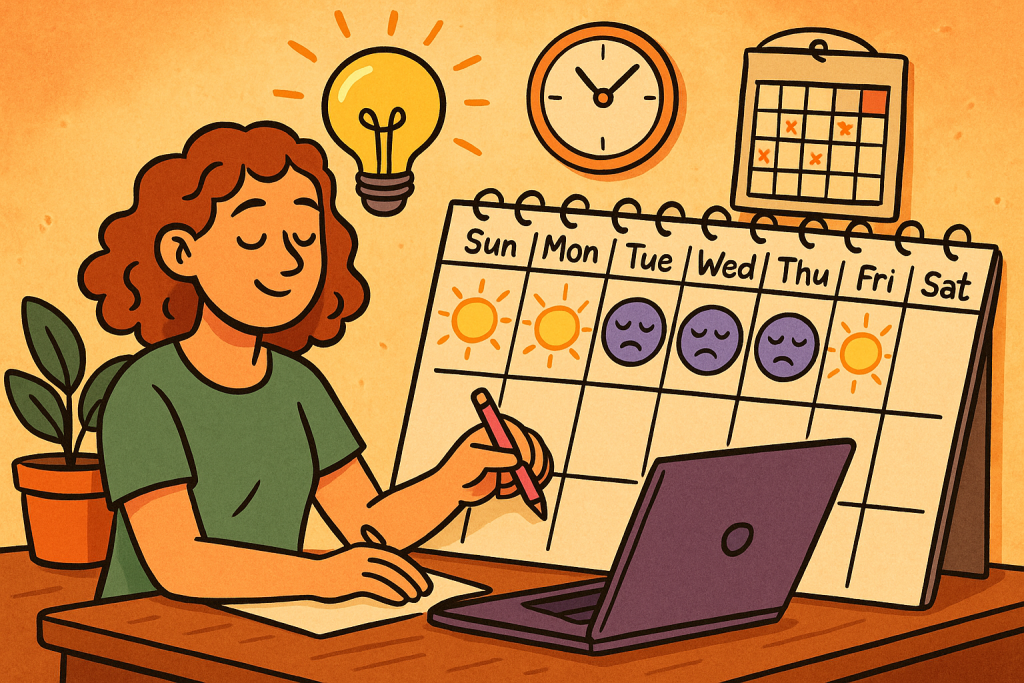Looking to boost productivity and energy? Learn how to design a week around energy, not deadlines—discover how aligning tasks with your natural rhythm can transform your workflow and well-being.

Why Planning by Energy Beats Deadline-Driven Scheduling
Traditional schedules focus on deadlines, often ignoring our energy patterns. But overloading high-demand tasks in low-energy slots leads to burnout, stress, and subpar results. Research shows that recognizing your daily chronotype—whether you’re a lark, owl, bear, or wolf—helps align tasks with your cognitive peaks. Harvard Business Review emphasizes assigning important tasks during peak alertness and routine tasks in low-energy periods.
Step 1: Discover Your Chronotype
Understanding your chronotype is the foundation:
- Morning lark (early-bird) – Energy peaks early; best for demanding tasks in the morning
- Night owl – Tend to perform best later; important tasks should be scheduled post-noon
- Bear or intermediate – Most align with traditional 9–5 rhythm
How to Identify It:
- Track your energy for 1–2 weeks. Note when you feel most alert, creative, or fatigued.
- Use a sleep app or a quick quiz. Sleep Cycle and Zapier provide simple self-assessment tools.
- Observe your weekend rhythm: free sleep and wake times reflect your natural tendency.
Step 2: Map Your Energy Rhythms
Once you know your chronotype, sketch your weekly energy zones:
- Peak hours (focus & complex work)
- Trough hours (routine, admin tasks)
- Recovery windows (breaks, walks, low-effort tasks)
Example: Morning Lark
| Time | Monday–Friday | Weekend |
|---|---|---|
| 6–9 AM | Peak – deep work/projects | Leisure or errands |
| 9–11 AM | Moderate – emails/meetings | Relaxed tasks |
| 11 AM–2 PM | Trough – routine admin | Flex time |
| 2–4 PM | Secondary Peak – editing | Active/social time |
| 4–6 PM | Low Focus – wrap‑ups | Leisure/exercise |
Tailor this mapping based on your chronotype and lifestyle.
Step 3: Assign Task Zones
Peak Energy Slots
- Deep research, coding, creative writing
- Strategic thinking or problem-solving
Secondary Peaks / Mid-Energy
- Editing, planning, client or team check-ins
Trough Periods
- Answering emails
- Routine admin and low-focus tasks
Recovery & Breaks
- Physical activity, brief walks, lunch
- Creative hobbies, light reading—these recharge and support productivity
Step 4: Build the Weekly Template
- Create 2–3 Peak Blocks on high-energy days (Mon, Wed, Fri).
- Reserve trough blocks daily for routine follow-up.
- Integrate buffer zones—breaks, meals, short rest.
- Schedule meetings in mid or low-energy zones to preserve focus.
Sample Week for Lark:
- Mon/Wed/Fri: 6–9 AM deep work / 9–11 AM meetings / 11–2 PM admin / 2–4 PM follow‑ups
- Tue/Thu: 6–9 AM planning / 9–11 AM content creation / 11–2 PM routine / 2–4 PM light tasks
Adjust the weekend plan to maintain rhythm or take needed recovery.
Step 5: Fine-Tune with Data
- Use sleep trackers or energy logs to refine awareness.
- Be flexible: sometimes deadlines interfere—shift tasks, not flat‑out effort.
- Check-in weekly: What worked? What backfired?
Why This Method Works
Enhanced Focus
Matching peak energy with complex tasks improves attention and output.
Sustained Well-Being
Energy-aligned weeks reduce burnout, boost mood and resilience.
Greater Creativity
Trough hours often spark sideways thinking. Harvard research confirms off‑peak creativity surges.
Better Scheduling
Categorizing slots helps trim unnecessary meetings and fosters proactive planning.
Bonus: Tips to Adapt When Schedules Conflict
Even with fixed hours or team demands:
- Shift internal tasks to your peaks—e.g., deep work before meetings.
- Use light therapy or morning exercise to adjust later chronotypes to early peaks.
- Break meetings into shorter blocks to preserve energy capacity.
- Remove friction: set auto-responders or block deep-work time in calendars.
Sample Weekly Outline (Bear Chronotype)
- Monday: 8–10 AM coding, 10–12 PM email/meeting, 12–1 PM recharge, 1–4 PM docs/planning
- Tuesday: 8–10 AM analysis, 10–12 PM meetings, 12–1 PM break, 1–4 PM admin
- …
Tools to Automate the Alignment
- Calendly: auto-set meeting windows
- Sleep tracking apps: Sleep Cycle, Oura
- Time-blocking apps: Notion, Google Calendar
- Focus tools: Forest, Focus@Will
Wrapping Up: Prioritize Energy, Not Time
Designing a week around energy means recognizing your natural rhythm and carefully matching tasks to cognitive readiness. This approach delivers:
- Enhanced productivity
- Improved mental health
- Consistent creativity
Customize based on your chronotype, refine through experience, and build in flexibility. Over time, you’ll find you’re not just meeting deadlines—you’re thriving through them.
References
Wharton Executive Education. “Designing Your Day for Maximum Productivity.” Wharton at Work, University of Pennsylvania, Oct. 2023.
www.executiveeducation.wharton.upenn.edu (2023).
Fritz, Charlotte, et al. “Daily Use of Energy Management Strategies and Occupational Well‑Being.” Frontiers in Psychology, vol. 8, 2017.
www.frontiersin.org/ (2017).
Time & Productivity. “Don’t Schedule Tasks — Design Energy.” Medium, May 2025.
www.medium.com (2025).






